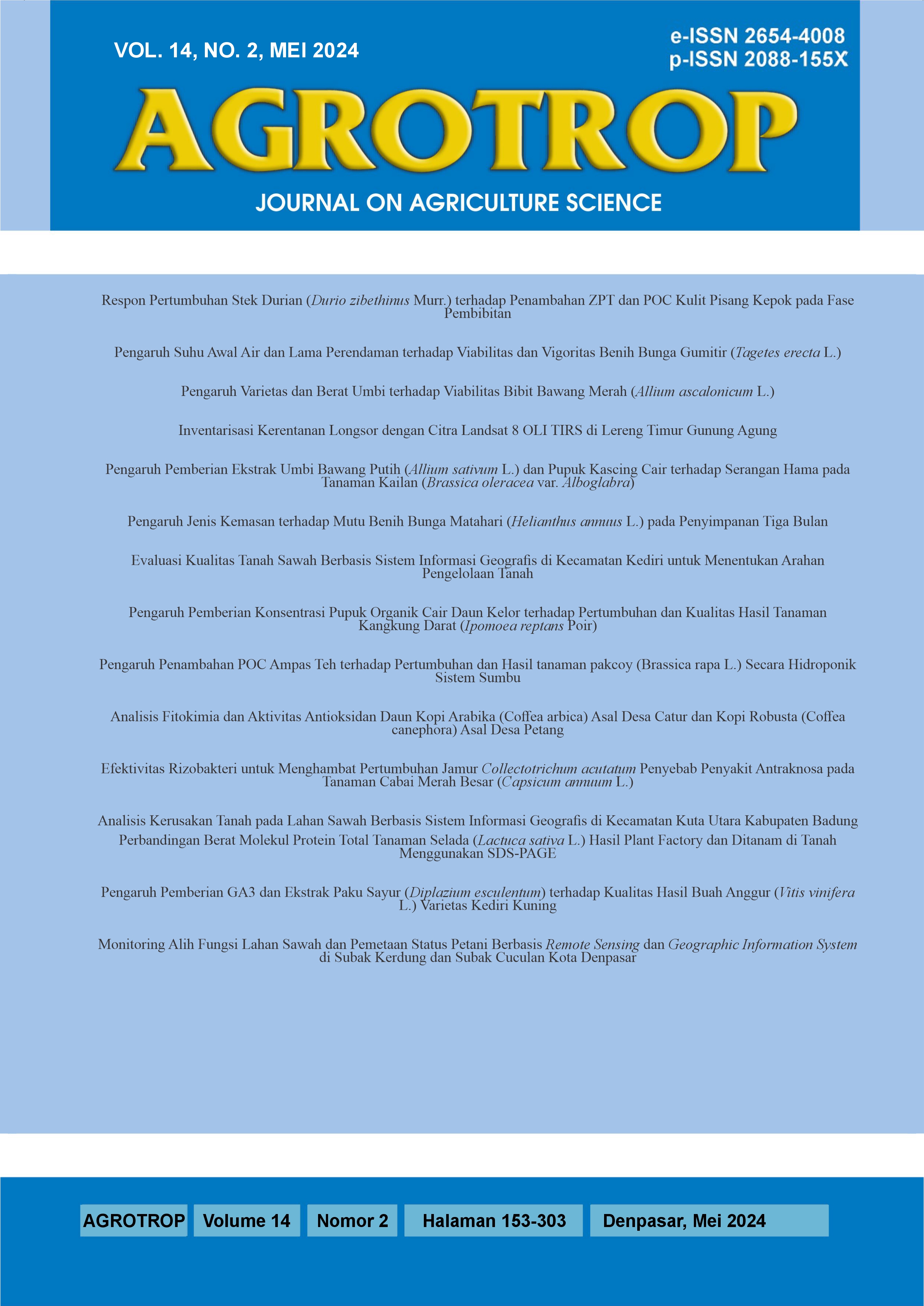Pengaruh Varietas dan Berat Umbi terhadap Viabilitas Bibit Bawang Merah (Allium ascalonicum L.)
Abstract
The Effect of Variety and Bulb Weight on the Viability of Shallot Seedlings (Allium ascalonicum L.). The demand for shallots continues to increase so production needs to be increased, one of the efforts that can be made is to provide good quality seeds. Viability is a benchmark in determining seedling quality. Seedling viability can be influenced by variety and bulb weight. This study aims to determine the effect of variety and bulb weight on the viability of shallot seedlings (Allium ascalonicum L.). The experimental design used is a completely randomized design (CRD) factorial pattern with two factors. The first factor is variety, namely Bali Karet, Biru Lancor, and Batu Ijo. The second factor is bulb weight, which is large (12-16 g), medium (8-12 g), and small (4-8 g). The research was conducted in the Greenhouse of the Experimental Garden of the Faculty of Agriculture, Udayana University, Denpasar from February to April 2023. The results showed that the variety treatment had a significant effect on the percentage of shoots. The highest percentage of shoots appeared in the Bali Karet variety which was 72.22%. The treatment of bulb weight has a very real effect on the viability of shallot seedlings. The highest viability is found in the weight of large bulb (12-16 g), namely the percentage of shoots appearing 73.33%, the time to appear shoots 5.95 days, shoot length 17.13 cm, root length 13.83 cm, and total dry weight of seedlings 0.74 g, and there is an interaction of varieties and bulb weight that has a very significant effect on shoot length and total dry weight of seedlings. The best treatment combination is found in the Bali Karet variety and the weight of large bulb (12-16 g), namely the highest shoot length and total dry weight of seedlings, namely 16.67 cm and 0.74 g.
Downloads
References
Badan Pusat Statistik. (2022). Produksi Tanaman Sayuran Menurut Provinsi dan Jenis Tanaman. Statistik Pertanian Hortikultura SPH/BPS-Statistics Indonesia, Agricultural Statistic for Horticulture SPH. https://www.bps.go.id/indikator/indikator/view_data_pub/0000/api_pub/eHEwRmg2VUZjY2lWNWNYaVhQK1h4QT09/da_05/1
Badan Pusat Statistik Provinsi Bali. (2021). Produksi Bawang Merah Provinsi Bali Menurut Kabupaten/Kota (Ton) 2019-2021. Statistik Pertanian Hortikultura SPH-SBS, Badan Pusat Statistik Republik Indonesia, Provinsi Bali. https://bali.bps.go.id/indicator/55/332/2/produksi-bawang-merah-provinsi-bali-menurut-kabupaten-kota.html
Direktorat Jenderal Hortikultura. (2013). Impor dan Ekspor Sayuran Tahun 2013. http://hortikultura.deptan.go.id/index.php?option=com_content&vie=article and id=33 7&Itemid=698
Direktorat Jenderal Perbenihan. (2017). Pedoman Sertifikasi dan Pengawasan Peredaran Mutu Benih, Direktorat Jenderal Tanaman Pangan dan Hortikultura, Jakarta (ID).
Elshyana, I.S., Lukiwati, D. R., & Karno, K. (2019). Respon Pertumbuhan True Shallot Seed Beberapa Varietas Bawang Merah (Allium cepa L.) terhadap aplikasi giberelin. Journal of Agro Complex, 3(3): 106-114.
Gunawan, M. (2012). Pengujian Bobot dan Daya Tumbuh Beberapa Varietas Bawang Merah di Lahan Pasang Surut Sumatera Selatan. Jurnal Hasil Penelitian LPPM, 03(2): 67-73.
Harjadi, S.S. (2012). Dasar-dasar Hortikultura. Departemen Budidaya Pertanian, Fakultas Pertanian, Institut Pertanian Bogor. Bogor. 506 p.
Hartmann, H.T., D.E. Kester. (2012). Plant Germination. Principles and Practice. Prentice Hall of India. New Delhi. 702 p.
Kementerian Pertanian. (2020). Outlook Komoditas Pertanian Subsektor Hortikultura Bawang Merah. https://psp.pertanian.go.id/
Kuswanto, D., B.S. Purwoko, A. Purwito, dan A.D. Susila. (2011). Perbanyakan Tunas Mikro Pada Beberapa Umur Simpan Umbi dan Pembentukan Umbi Mikro Bawang Merah Pada Dua Suhu Ruang Kultur. Jurnal Agronomi Indonesia, 7(39): 97-102.
Mutia, M. Muhammad. Anang, F. (2014). Pertumbuhan, Produksi, dan Kualitas Bawang Merah di Tanah Pasir Kuarsa Pedalaman Luar Musim. Jurnal Agroekoteknologi, 6(42): 271-278.
N. Nunez, Tabrani, G., R. Arisanti, dan Gusmawartati. (2018). Pengaruh Berbagai Suhu terhadap Viabilitas Bawang Merah (Allium ascalonicum L.). Jurnal Agroekoteknologi FP USU, 4(1): 24-31.
Maemunah. (2010). Viabilitas Benih dan Vigor Bawang Merah Pada Beberapa Varietas Setelah Penyimpanan. Jurnal Agroland, 17(1): 18-22.
Prastowo, N.H., J. M. Roshetko., G.E.S. Manurung. (2016). Tehnik Perkecambahan dan Perbanyakan Vegetatif Tanaman Bawang Merah. World Agroforestry Centre (ICRAF) dan Winrock International. Bogor.
Prawiranata W., Harran S., Tjondronegoro dan P. (2012). Basics of Plant Physiology. FMIPA. IPB. Bogor. 247 p.
Priyantono, E., Ete, A., dan Adrianton. (2013). Vigor Umbi Bawang Merah (Allium Ascallonicum L.). Varietas Palasa dan Lembah Palu Pada Berbagai Kondisi Simpan. e-J. Agrotekbis, 1(4): 8-16.
Schmidt, L. (2000). Pedoman Penanganan Benih Tanaman Hutan Tropis dan Sub Tropis. Direktorat Jenderal Rehabilitasi Lahan dan Perhutanan Sosial Indonesia Forest Seed Project. Buku. Gramedia. Jakarta. 530 p.
Sinaga, R., Waluyo, N., & Rosliani, R. (2016). Pengaruh GA 3 Terhadap Viabilitas dan Vigor Benih Bawang Merah Effect of GA 3 on Viability and Vigor of True Shallot Seed. Prosiding Seminar Nasional Pengembangan Teknologi Pertanian, 9-14.
Suita, E. dan Nurhasybi. (2008). Pengaruh Ukuran Bibit terhadap Perkecambahan dan Pertumbuhan Bibit Varietas Tajuk (Allium ascalonicum L.). Jurnal Tekno Hutan Tanaman, 14(2): 41-46.
Sumardi, I dan A. Pudjoarianto. (2006). Struktur dan Perkembangan Tanaman Bawang Merah. Fakultas Biologi. Universitas Gadjah Mada. Yogyakarta.
Sutopo, L. (2002). Teknologi Benih. Raja Grafindo Persada. Jakarta. 237 p.
Sutopo, L. (2012). Teknologi Benih. Fakultas Pertanian UNBRAW.
Jakarta. 237 p.
Suwandi., (1989). Pengaruh Dosis dan Waktu Aplikasi Pemupukan Fosfat Pada Tanaman Bawang Merah Terhadap Tanaman Bawang Merah Kultivar Sumenep I. Pertumbuhan dan Hasil. Jurnal Hortikultura, 28(2): 98-106.











